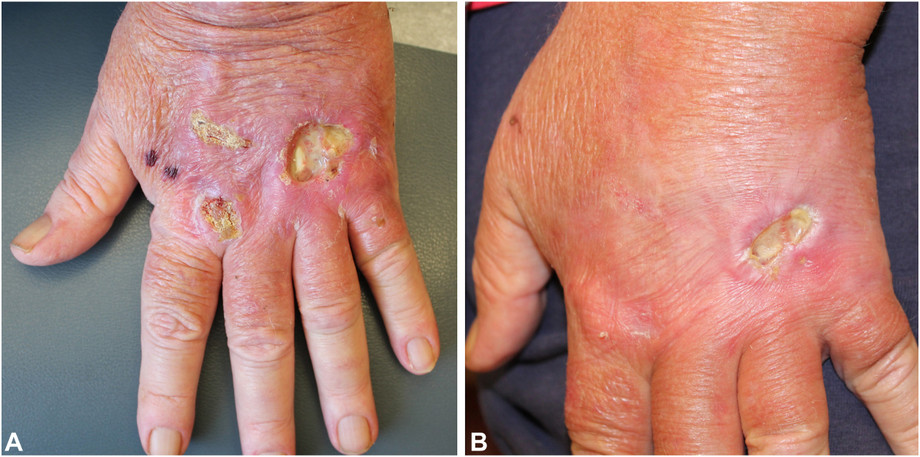Introduction
Pyoderma gangrenosum (PG) is a rare, chronic, neutrophilic dermatosis characterized by painful, necrotic ulcers with undermined, violaceous borders. While its exact pathogenesis remains unknown, it is considered an autoinflammatory disease. Treatment aims to control underlying inflammation and promote wound healing. A multidisciplinary approach involving dermatology and rheumatology is often required.
Causes and Diagnosis
The precise cause of PG is unknown, though it often arises secondary to underlying systemic disease such as inflammatory bowel disease, arthritis or hematologic disorders. Trauma to the skin from minor cuts or insect bites can trigger the onset of lesions in susceptible individuals. Diagnosis is based on clinical presentation and typically confirmed by exclusion of other conditions through biopsy.
First Line Pyoderma Gangrenosum Treatment: Systemic Corticosteroids
Systemic corticosteroids such as prednisone remain first line therapy for PG due to their potent anti-inflammatory properties. Oral prednisone dosed at 0.5-1mg/kg/day is usually initiated and slowly tapered over many months once lesions begin to resolve. Higher initial doses may be required for severe or refractory cases. Topical corticosteroids alone are generally inadequate treatment.
Second Line Agents: Immunomodulators
For patients who do not respond adequately to or are unable to tolerate systemic corticosteroids, immunomodulatory drugs are often employed as secondary options. Common choices include calcineurin inhibitors (cyclosporine, tacrolimus), mycophenolate mofetil, methotrexate, azathioprine or antitumor necrosis factor (TNF) agents like infliximab. These broad-spectrum immunosuppressants aim to control the deregulated inflammatory response underlying PG pathogenesis.
Role of Biologics
Biologic response modifiers have emerged as particularly effective alternatives for treating PG refractory to corticosteroids and traditional immunosuppressants. Infliximab, a chimeric monoclonal antibody against TNF-alpha, shows the highest reported success rates with around 70-80% of patients achieving remission or significant improvement in lesions. Other biologics implicated in PG including adalimumab, etanercept and ustekinumab through their anti-inflammatory effects. Careful monitoring is required due to potential adverse effects.
Supportive Measures
Supportive measures play an adjunctive role in PG management alongside pharmacologic therapies. Frequent dressing changes with moist wound healing techniques promotes rapid lesion resolution. Topical antibiotics may prevent or treat secondary infection in open ulcers until inflammation subsides. Dietary modifications are advised for IBD-associated cases. Psychological support may also benefit patient coping and long-term adherence to pyoderma gangrenosum treatment regimens.
Surgical Interventions
While surgery typically does not treat underlying pathology, it may have a role in severe, complicated cases unresponsive to medical management. Drainage of superficial abscesses or debridement of necrotic tissue especially around major joints helps prevent functional impairment and minimizes risks of systemic infection or sepsis. Skin grafting can expedite healing of refractory wounds. Care must be taken to ensure adequate control of inflammation prior to any invasive procedures.
Managing Flares and Maintenance
Disease flares are common in PG, even after achieving remission with initial pyoderma gangrenosum treatment . triggers include infection, surgery, emotional or physical stress and discontinuing medications prematurely. Gradually tapering therapy over many months aims to prevent relapses. Infliximab maintenance every 6-8 weeks has shown benefit for recurrent cases. Adjunctive low-dose immunosuppression may also minimize flares. Early recognition and reinstitution of potent anti-inflammatory/immunomodulatory regimens is key when active lesions recur. Long-term management focuses on controlling underlying triggers and tailoring a maintenance protocol individualized to each patient.
Prognosis
Prognosis depends on the severity and extent of disease as well as response to treatment. Approximately 50% of cases eventually achieve full remission, while others experience a relapsing-remitting course requiring chronic immunosuppression. Mortality is rare but infection poses the greatest risk in immunosuppressed patients. With a multidisciplinary approach, early aggressive pyoderma gangrenosum treatment and careful long-term management, the outlook for most PG patients is favorable.
About Author:
Ravina Pandya, Content Writer, has a strong foothold in the market research industry. She specializes in writing well-researched articles from different industries, including food and beverages, information and technology, healthcare, chemical and materials, etc. (https://www.linkedin.com/in/ravina-pandya-1a3984191)
*Note:
1. Source: Coherent Market Insights, Public sources, Desk research
2. We have leveraged AI tools to mine information and compile it

